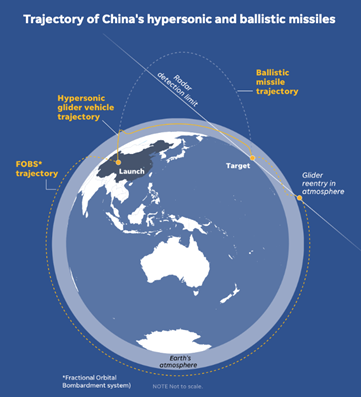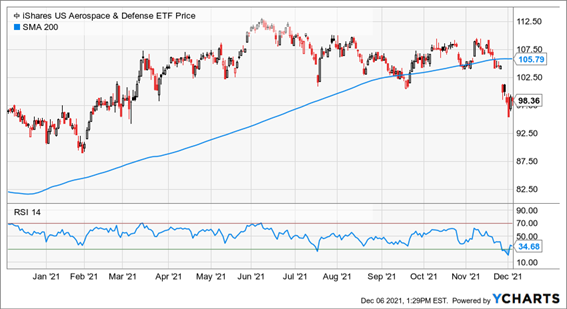Today’s “Sputnik moment” is again spurring calls for spending. And lots of it.
Did you hear about China’s hypersonic missile test last summer?
The one that circumnavigated the world before impacting the ground a mere 19 miles from its target back in China.
General John Hyten of the Joint Chiefs of Staff warned that hypersonic missiles "look like a first-use weapon. That's what those weapons look like to me."
This comes at the same time as China is threatening “reunification” with Taiwan ... making provocative incursions into Taiwanese airspace ever more frequently.
Even scarier is that, according to the Pentagon, China could have 1,000 nuclear warheads to put on those missiles by the end of the 2020s.
Worse yet, China’s hypersonic glide vehicle could evade U.S. missile defense.
- And now we hear Russia is joining the hypersonic club.
At Mach 9, Russia's Tsirkon 3M22 missile is at the low end of the hypersonic spectrum. But it’s been launched numerous times since January 2020 and is being continuously refined.
Moscow says it can hit targets at a range of up to 1,000 kilometers (660 miles). That falls far short of China’s recent feat. But don’t let that comfort you ...
Russia reportedly test-fired the missile from its Severodvinsk submarine in the Barents Sea. If true, this changes the calculus entirely.
Russian submarines could launch rapid strikes from hidden locations underwater ... as long as they’re within 1,000 kilometers off our coast (or our military bases).
- President Vladimir Putin claims Russia will have a fully operational sea-based hypersonic weapon in service sometime in 2022.
"I think it changes the nuclear balance versus the U.S.," said Defense and National Security Editor Brent M. Eastwood.
- "As an anti-ship missile, it might overwhelm the American Aegis Combat System," he told Newsweek.
"Aegis needs eight to 10 seconds of reaction time to intercept incoming missiles. However, in that time, the Tsirkon will have already traveled at least 12 miles ... we must worry that Tsirkon could have an accidental launch that could spark a nuclear exchange.”
Considering these developments, the Pentagon is scrambling.
"The U.S. has done a lot of testing the purer hypersonic jets and coming up with all sorts of obstacles," Eastwood told Newsweek.
Wakeup Call
It all reminds me of when the Russians launched Sputnik. (Let’s hope the U.S. responds in similar fashion now as it did then).
The first American response to Sputnik blew up on launch ... while a hypersonic vehicle test similarly failed this past October.
However, by 1960, the U.S. had three times as many satellites orbiting Earth as the Soviets.
Washington Post journalist Fareed Zakaria says that "raising fears about a huge and tech-savvy enemy is a surefire way to guarantee vast new budgets that can be spent countering the enemy's every move, real or imagined."
And "real or imagined" is the big problem when it comes to hypersonic weapons.
To quote former U.S. Defense Secretary Donald Rumsfeld:
There are things we know we know. We also know there are known unknowns. That is to say, we know there are some things we do not know. But there are also unknown unknowns, the ones we don't know we don't know.
- All the uncertainty is spurring the Pentagon to up spending on hypersonic systems — offense AND defense ... to a reported $3.8 billion next year.
How to Play It
A lot of that money will go towards research and development of a “glide phase interceptor” ... a hypersonic vehicle that would be guided by a constellation of satellites and sensors to intercept an enemy’s hypersonic missile as it glides towards its target.
The Missile Defense Agency just awarded three defense contractors — Northrop Grumman (NYSE: NOC), Lockheed Martin (NYSE: LMT) and Raytheon (NYSE: RTX) — an initial $60 million each to develop this system.
Any of these companies are worthy recipients of investment dollars, but it could be difficult to pick which one emerges as the winner of the hypersonic missile race:
- Raytheon, which is trading at $84.25 at the time of writing, is up over 15% in the past year, but it has been rangebound since April.
- Lockheed Martin, currently trading at $342.07, is off its 52-week high by nearly $55.
- And Northrop Grumman has been trading sideways between $338 and $406 since April.
A potentially safer bet, and one that exposes investors to a basket off defense stocks, is the iShares U.S. Aerospace & Defense ETF (NYSE: ITA), which holds all three of the aforementioned companies among other defense stocks.
Despite its price recently tumbling well below its 200-day moving average, it is testing critical support around $97. And the relative strength index (RSI), a technical indicator, shows that shares just broke above 30 … where stocks are considered “oversold.”
As always, make sure you conduct your own due diligence before entering any position.
But no matter which way investors play it, the profits here could be hypersonic.
All the best,
Sean



